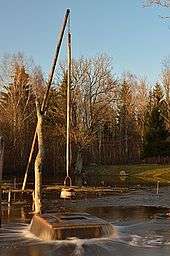Shadoof
A shadoof or shaduf[1] (from the Arabic word شادوف, šādūf) is an irrigation tool. It is highly efficient, and has been known since 3000 BCE.
Names
It is also called a counterpoise lift,[2] well pole, well sweep, or simply a sweep in the US.[3]A less common English translation is swape.[4] it is also called a Jiégāo(桔槹) in Chinese.
History
The shadoof, or sweep, was an early crane-like tool with a lever mechanism, used in irrigation since around 3000 BCE by the Mesopotamians,[5] 2000 BCE by the ancient Egyptians,[6] and later by the Minoans, Chinese (c 1600 BCE), and others.[7] Irrigation is a way of watering crops using basins, dikes, ditches, walls, canals, and waterways. The sweep was used to lift water from a river or lake onto land or into another river or lake. The mechanism comprises a long pole with a bucket attached to the end of it.[8] It is still used in many areas of Africa and Asia and very common in rural areas of India such as in the Bhojpuri belt of the Ganges plain where it is named "dhenki". They remain common in Hungary's Great Plain, where they are known as "gémeskút" (literally, "heron wells") and are considered a symbol of the region.[9] It was also known by the Ancient Greek name kēlōn (κήλων) or kēlōneion (κηλώνειον); this term (קילון) is also borrowed in Mishnaic Hebrew.[10]
Construction
The sweep is easy to construct and is highly efficient in use[2] It consists of an upright frame on which is suspended a long pole or branch, at a distance of about one-fifth of its length from one end.[2] At the long end of this pole hangs a bucket, skin bag, or bitumen-coated reed basket. The bucket can be made in many different styles, sometimes having an uneven base or a part at the top of the skin that can be untied. This allows the water to be immediately distributed rather than manually emptied. The short end carries a weight (clay, stone, or similar) which serves as the counterpoise of a lever: The bucket can be lowered by the operator using his own weight to push it down; the counterweight then raises the full bucket without effort.[2][6]
With an almost effortless swinging and lifting motion, the waterproof vessel can be used to scoop up and carry water from a body of water (typically, a river or pond) onto land or to another body of water. At the end of each movement, the water is emptied out into runnels that convey the water along irrigation ditches in the required direction.[6]
The sweep has a lifting range of 1 to 6 metres. A study of efficiency in various sites in Chad has shown that one man can lift 10-34 gallons per minute over heights of 5.9-20 feet, and its efficiency has been calculated at 60%[1]
References
- "ASABE technical paper describing alternative names". Asae.frymulti.com. Archived from the original on 2011-07-11. Retrieved 2012-04-03.
- D. T. Potts (2012). A Companion to the Archaeology of the Ancient Near East. John Wiley & Sons. p. 264.
- Knight, Edward Henry. Knight's American mechanical dictionary. Vol. 3. New York, Hurd and Houghton: Riverside Press, 1877. 2,468. Print.
- "Definition of "Swape"". Webster's Revised Unabridged Dictionary. MICRA Inc. Retrieved 2007-04-25.
- Paipetis, S. A.; Ceccarelli, Marco (2010). The Genius of Archimedes -- 23 Centuries of Influence on Mathematics, Science and Engineering: Proceedings of an International Conference held at Syracuse, Italy, June 8-10, 2010. Springer Science & Business Media. p. 416. ISBN 9789048190911.
- Faiella, Graham (2006). The Technology of Mesopotamia. The Rosen Publishing Group. p. 27. ISBN 9781404205604.
- Yannopoulos, Stavros; Lyberatos, Gerasimos; Theodossiou, Nicolaos; Li, Wang; Valipour, Mohammad; Tamburrino, Aldo; Angelakis, Andreas (2015). "Evolution of Water Lifting Devices (Pumps) over the Centuries Worldwide". Water. 7 (12): 5031–5060. doi:10.3390/w7095031. ISSN 2073-4441.
- John Roberts (historian), edited by Allen Lane (2013). The Penguin History of the World. Penguin Books.
- Hortobágy National Park
- wiktionary.org/wiki/קילון
External links
| Wikimedia Commons has media related to Shadoofs. |


